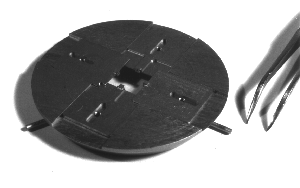
The best option turned out to be to mechanically mount the substrates over a hole in the Mo block, so that the substrates would be heated directly by radiation. The first sample holder prototype #1 was designed for 1'' round substrates and consists of a 0.98'' hole in the Mo block and a 1.05'' lip, 0.01'' deep, to allow the substrate about 0.02'' thick to be seen by the RHEED beam (extruding from the holder). The substrate was held in place by 2 opposing Tantalum (Ta) clips exerting some pressure upon the substrate.
Originally sapphire substrates mounted in this holder did not get hot enough for GaN growth due to the large radiation loss passing through the sapphire. This problem was completely solved by applying 2000 Å of Titanium (Ti) via e-beam evaporation to the back side of the substrates. As it turned out sapphire substrates tend to crack at high temperature due to the pressure exerted by the clips. Also, heating was fairly uneven lowering the substrate temperature in the vicinity of the clips by about 50°C, as determined by the balance point method using RHEED as discussed in another section.
The second prototype #2 has a similar design, but much tighter tolerances, and features a force free clip mount. The hole has a diameter of 0.98'' while the lip is only 1.01'' in diameter, using the same depth of 0.01''. The clips were applied force free to the substrate by spacers. As it turned out, substrates did not crack anymore, but occasionally fell out of the sample holder.
A final prototype #3 was build taking care of all the previous problems (see Figure 17 and Figure 18). Instead of the clips a self centering ring is holding the substrate in place, designed to only block the RHEED beam at 3 places. The mount is force free and makes contact with the sample at 3 small places, therefore providing very uniform heating. This substrate holder turned out to be a full success. A similar sample holder was developed to accommodate any rectangular substrate, ranging from over 0.5'' down to 0.2'' (see Figure 19 and Figure 20). Movable Mo plates with small force free clips at the end move in tracks machined onto the Mo block, interleaving with one another. This ensures that there is no open space with a direct line of sight to the heater to prevent heat loss and contamination. Note that the original drawing (Figure 19) was not applied exactly as shown in the design, but the interleaving action was modified to permit easier machining as shown in Figure 20.
Note that simpler sample holders as the ones described cause a number of problems. Just using a hole in a Mo block and covering it completely with a substrate causes the portions of the substrate with no direct line of sight to the heater to be much colder than the rest of the substrate, resulting in very uneven growth. Using a hole that is larger than the substrate and wires to hold it into place causes to much radiation to be lost through the hole, as well as the possibility of contamination from the heater can not be ruled out. Finally, any non rigidly mounted substrate tends to be uneven in place and might cause problems with the lineup of the RHEED gun.

Figure 17: Substrate holder for 1'' round samples


Figure 18: Photograph (Ref. 23) of substrate holders for 1'' round samples

Figure 19: sample holder for square substrates of variable size


Figure 20: Photograph (Ref. 23) of substrate holder for square samples of variable size
Table of Contents